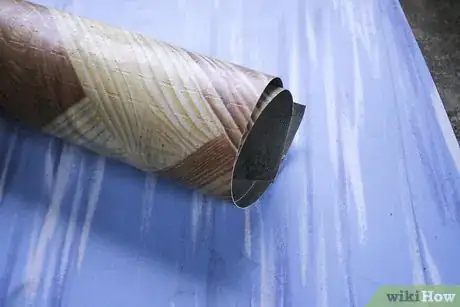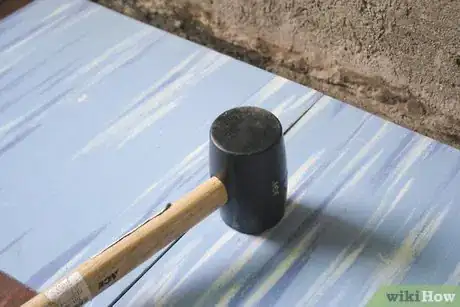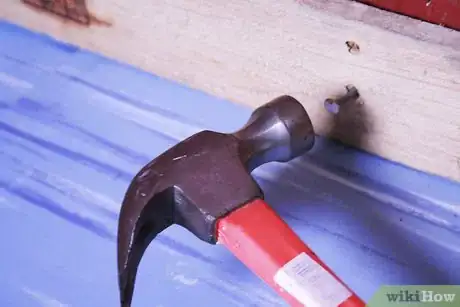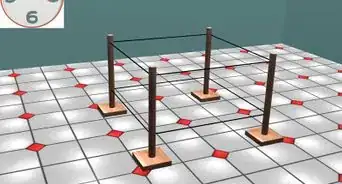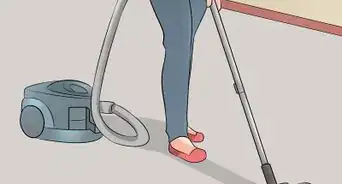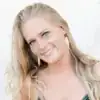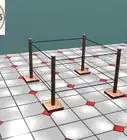This article was co-authored by Crystal Chadwick. Crystal Chadwick is a Licensed General Contractor and the Owner of Yin & Yang Construction out of Salt Lake City, Utah. With over 16 years of experience in the construction industry, she specializes in remodels, repairs, and handyman services. Crystal leads her team with vision and a detail-oriented approach, allowing them to provide quality work and design to their clients.
wikiHow marks an article as reader-approved once it receives enough positive feedback. In this case, several readers have written to tell us that this article was helpful to them, earning it our reader-approved status.
This article has been viewed 98,549 times.
Linoleum is a resilient, durable type of flooring typically used in kitchens and bathrooms. When linoleum gets old, it can crack and turn yellow. Replacing linoleum involves removing it and installing new flooring. This process can be very difficult depending on your sub-surface. Use these steps to replace linoleum floors.
Steps
-
1Determine your subsurface.
- If you do not already know what kind of flooring lies underneath your linoleum, you will need to find out in order to remove the old linoleum properly.
- Choose a corner of linoleum that is the most ragged or curled and try to pry it loose with your fingers. You only need to see a small portion of the floor to identify it. Common sub-surfaces include hardwood, concrete and vinyl flooring.
-
2Pull off any trim or molding that borders your floor using the backside of a hammer.Advertisement
-
3Remove old linoleum.[1]
- Cut the linoleum into strips approximately 6 inches (15.24 cm) wide. Linoleum isn't very thick. Cut only as deep as the linoleum. You will feel the hard subsurface when you hit it. Try not to scrape the subsurface.
- Peel a corner of the linoleum slowly with two hands. Reposition your hands down as your peel.
- Continue onto the next strip of linoleum.
- Discard the strips in the trash.
- Boil water in a medium saucepan.
- Pour the boiling water onto the remaining linoleum and adhesive on the floor.
- Cover the floor with damp towels to keep the surface wet.
- Wait 10 minutes.
- Use a floor stripper to scrape away the remnants of linoleum and adhesive.
- Repeat the process of boiling water and pouring it onto the floor. This should remove the last of the glue.
-
4Prepare the subsurface.
- Ensure the subfloor is smooth and level.
- Oriented strand board or OSB is best for the subfloor or underlayment.
- Fill in the cracks, gaps, or holes with a wood filler.
- Smooth the floor as much as possible. This might involve refinishing or resurfacing. Hardwood floors should be sanded down.
-
5Measure the length and width of the room and multiple the numbers together to find the area.[2]
-
6Purchase either linoleum tiles or linoleum sheets.[3]
- Both are made of the same material, but sheets tend to last longer because there are fewer places for the linoleum to curl or warp.
-
7Install the new linoleum.[4]
- Determine the layout of the sheets or tiles. Place your linoleum on the floor as a run-through before the actual adhesion process.
- Cut the appropriate tiles or sheets to move around bathroom or kitchen fixtures or components such as counters and plumbing.
- Spread adhesive to a small area on the floor.
- Press the linoleum onto the adhesive firmly.
- Continue to apply adhesive and press the linoleum into the subsurface.
- Roll over the tiles or sheets with a 100-pound (45.4-kg) roller.
-
8Replace any trim or molding you removed earlier.
Community Q&A
-
QuestionHardwood floors adjoin linoleum floor in a bathroom. How can I level them so that it all is even without having to use a strip in between?
 Community AnswerYou'll have to either remove one and lower it's sub-floor or the wood will need to be sanded down to the linoleum.
Community AnswerYou'll have to either remove one and lower it's sub-floor or the wood will need to be sanded down to the linoleum. -
QuestionIs there a non-toxic adhesive that can be used with linoleum within an infant/toddler area?
 Community AnswerNo, but the adhesive will never be exposed nor even remotely accessible in any way.
Community AnswerNo, but the adhesive will never be exposed nor even remotely accessible in any way. -
QuestionDo you think heat can shrink a stretch bubble in the linoleum?
 Community AnswerI doubt it, heat will probably expand a bubble. Heat causes expansion and may have been what caused it in the first place.
Community AnswerI doubt it, heat will probably expand a bubble. Heat causes expansion and may have been what caused it in the first place.
Warnings
- Be careful when scraping glue from the subsurface if the subsurface is made of vinyl or hardwood so you do not gouge the floor.⧼thumbs_response⧽
- Always wear gloves and a face mask when installing new linoleum.⧼thumbs_response⧽
- Do not replace linoleum in bare feet. The boiling water will burn you and it's possible to cut your feet on a jagged subsurface.⧼thumbs_response⧽
- Be aware of asbestos when removing old linoleum. Linoleum manufactured in the 1970s often contained the toxic substance.[5]⧼thumbs_response⧽
Things You'll Need
- Putty knife
- Utility knife
- Hammer
- Water
- Saucepan
- Stove
- Towels
- Floor stripper
- Refinishing tools
- Measuring tape
- Linoleum tiles or sheets
- Linoleum adhesive
- 100-pound roller
- Gloves
- Shoes
- Face mask
References
- ↑ https://todayshomeowner.com/how-to-remove-glued-down-linoleum-or-vinyl-from-a-wood-floor/
- ↑ https://www.youtube.com/watch?v=pbzL6U8L00I
- ↑ https://www.theflooringlady.com/install-linoleum-flooring-step-step-guide/
- ↑ https://www.youtube.com/watch?v=i9S7z_8QWc0
- ↑ http://www.swcleanair.org/docs/misc/asbestos_flooring.pdf
- http://www.findanyfloor.com/pub/pdf/InstallingLinoleumFlooring-FullGuide.pdf





